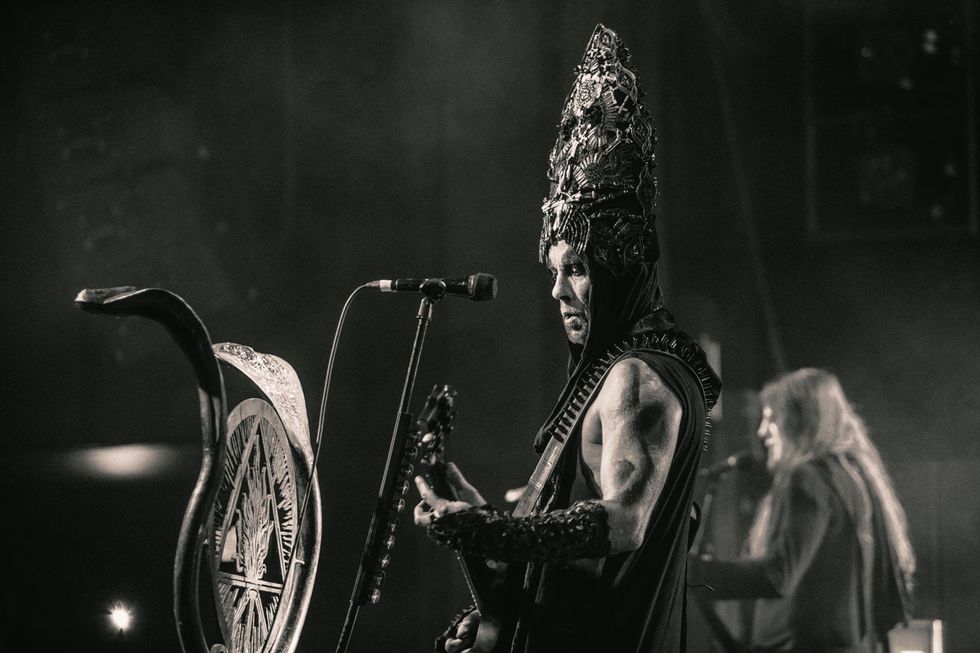This Takamine F-450S-A is a 14-fret dreadnought with a spruce top and rosewood back and sides.
This ’70s Japanese lawsuit-era guitar was brazenly designed to mimic a Martin D-41, and to our columnist’s ears, sounds just as good as the original.
It’s a 14-fret dreadnought acoustic with a spruce top and rosewood back and sides. It’s appointed with beautiful reduced-hexagon abalone inlays, matching binding, and multi-stripe detail throughout. The logo reads vertically instead of horizontally, and it has a rich, powerful tone. Surely I’m referring to an heirloom-quality, America-made Martin D-41, right?
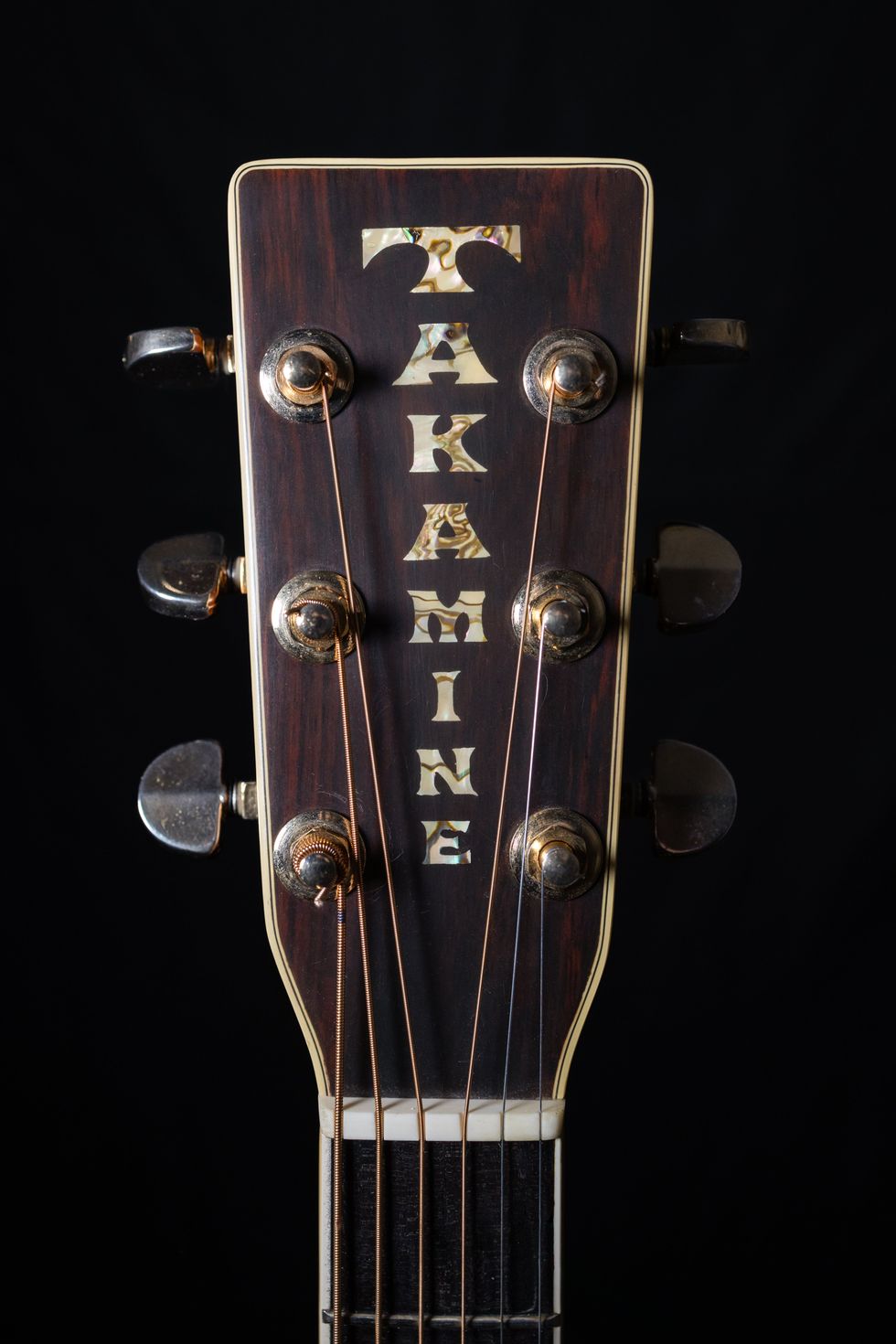
On the headstock, Takamine imitated the style of the vertical Martin logo. Takamine took the same approach to their Guild and Gallagher copies.
Nope! I’m talking about the delightful 1978 Takamine F-450S-A, an unashamed, fractions-of-an-inch-accurate copy of one of Martin’s most prized designs. According to Takamine’s 1976 catalog, the F-450S-A was “the finest guitar made by Takamine,” featuring genuine Pacific abalone pearl inlaid by hand. The catalog boasts of the experienced older craftsman slowly teaching young apprentices the “Takamine way” to make guitars. While there can be no doubt the F-450S-A is a fine instrument, the Takamine way sure looks a lot like the Martin way to us!
A revealing statement can be found just a page further in the catalog: “To the eye and to the ear, a Takamine matches any guitar on the market today.” You don’t say!
“To the pocketbook however, a Takamine is no match. Play and compare. You’ll find the sound you want at about a third the price.”
The logic was simple: A quality Martin clone made cheaply in Japan could easily be marketed to American consumers who couldn’t afford the real thing. While researching, I came across this illuminating post on The Unofficial Martin Guitar Forum: “Being from Western North Carolina and picking out with older folks on porches, I could never afford a Martin. When we would be picking, others would come up and say I like your Mar... tin... and then stop and look like they took a bite out of a rotten tater.”
Takamine mimicked other brands, too. The same 1976 catalog features the name “Takamine” contorted into the distinctive “peaked” Guild logo. Not too long ago, we had a Takamine-made Gallagher copy come into Fanny’s House of Music, with the famous Gallagher “G” subtly morphed into a “T.” This period in the 1970s is often called the “lawsuit era,” a term that refers to a 1977 lawsuit filed by Gibson against Ibanez for infringing on their headstock design. The phrase “lawsuit era” might suggest that American companies were suing their Japanese counterparts left and right, but the truth is, lawsuits were rare, and Gibson and Ibanez settled out of court. There was no lawsuit against Takamine for their headstocks, although Martin did send a cease and desist letter. Soon, Takamine, Ibanez, and other Japanese companies began cranking out great original designs of their own, and the lawsuit era was over.
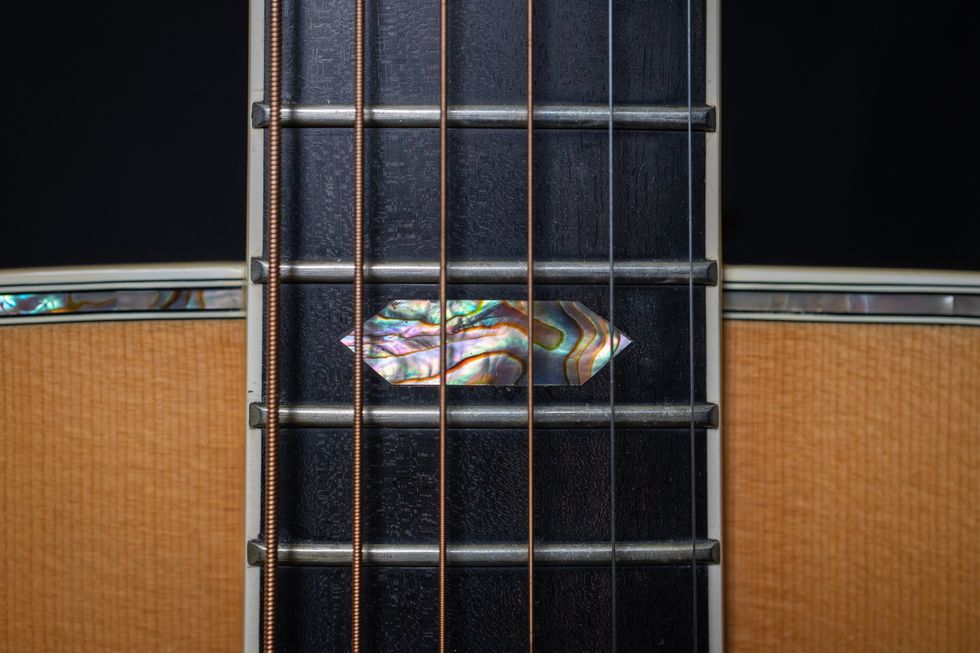
The oblong-hexagon abalone inlays on the fretboard are another feature of this guitar that resembles a Martin.
According to the Takamine catalog, the back and sides of our F-450S-A are made of jacaranda, and, boy, did that ever send me down a rabbit hole! It sure looks a lot like rosewood to me. Besides, with everything else on this guitar being such a close copy of a D-41, why would Takamine use an entirely different species of wood for the back and sides? Jacaranda is a genus of 49 species of flowering plants, and rosewood belongs to the genus Dalbergia, which famously does not flower. Everyone knows that. (Just kidding.)
As it turns out, the journey the word “jacaranda” takes from Portuguese to Japanese to English can leave us with a term that generally means “rosewood,” even though jacaranda is a very different species. Washburn, Tokai, and other Japanese manufacturers sometimes even listed fretboard material as “Jacaranda (Brazilian Rosewood),” which is nearly enough to turn my brain to mush! At a certain point, one has to admit defeat and begin climbing out of the rabbit hole. We may never know exactly what species of wood we’re dealing with here, but who cares when the guitar sounds this good?
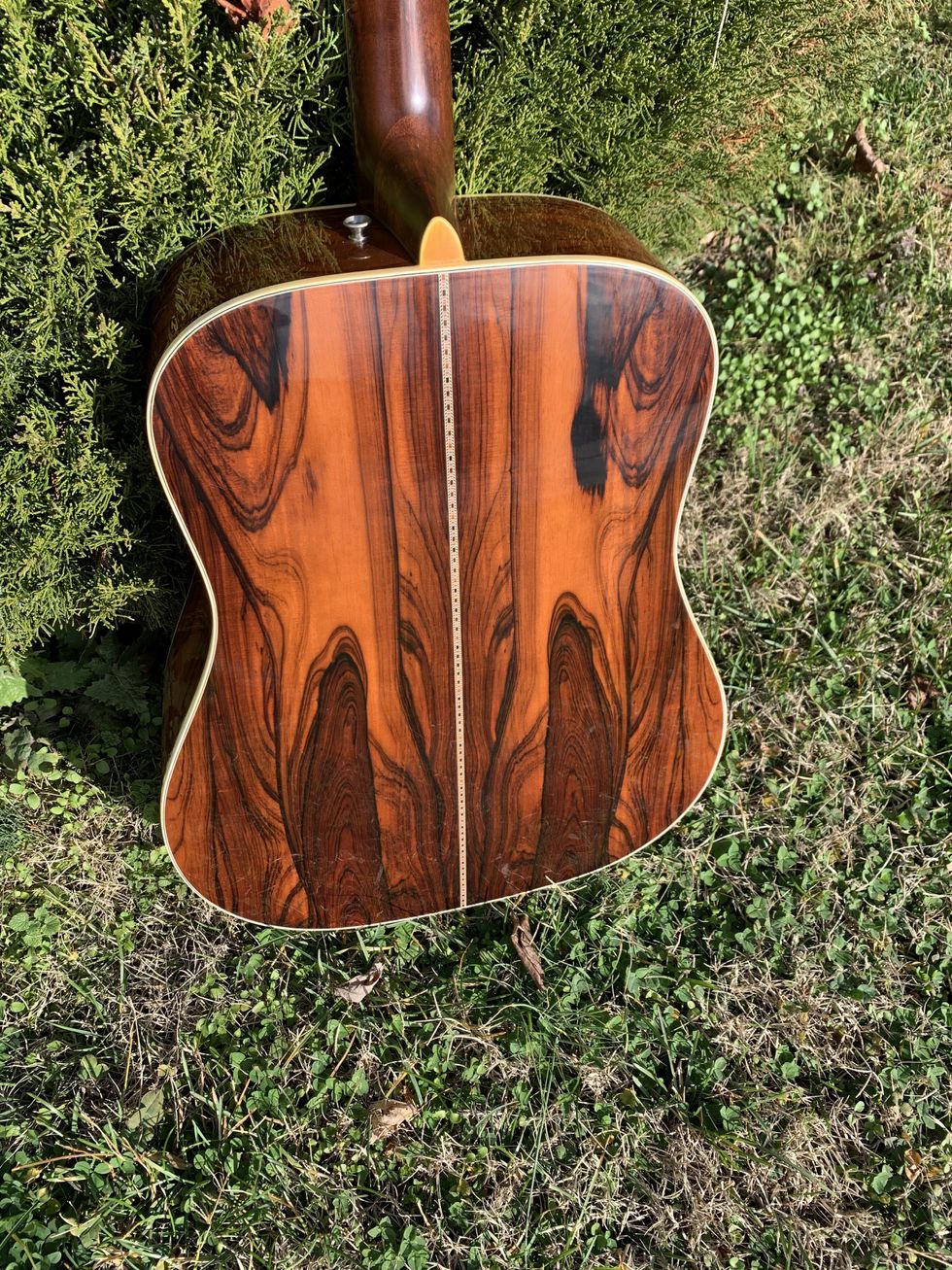
The Takamine catalog says the back and sides are jacaranda, a colloquialized umbrella term that often just means “rosewood.”
The neck of our Tak’ has a comfortable medium-C shape and nice low action. It’s clearly a well-built instrument with good volume and depth of tone. It’s in outstanding condition for its age, with hardly a mark on it, which means there’s a lot of songs in this old gal! It may be a mere “knock-off,” but don’t knock it ’til you try it. It’s a great guitar and I can’t wait to see who it inspires next.
The influential extreme-metal frontman on I Loved You at Your Darkest and why flouting the genre’s mores is essential to its survival.
Since their debut nearly 30 years ago, Polish metal outfit Behemoth has always been unapologetically intense—musically, lyrically, and aesthetically. But with 10 studio albums now in the band’s wake, their sound has developed from a potent take on black metal’s fury into a multifaceted beast that flexes with dynamic sensibility and nuance rarely seen in extreme metal. With their 11th studio LP, the monumental I Loved You at Your Darkest, vocalist/guitarist/bandleader Adam “Nergal” Darski, bassist Thomasz “Orion” Wróblewski, and drummer Zbigniew “Inferno” Promiński (along with hired-gun lead guitarist Patryk “Seth” Sztyber) have submitted a mission statement that puts artistry at the forefront and defies the notion that great metal thrives exclusively on bludgeoning guitars and maxed faders.
A far cry from the lo-fi sonic blizzards of early Behemoth releases, I Loved You at Your Darkest is a punishing yet surprisingly diverse stomp down paths not unlike those the band took on 2014’s The Satanist. Nergal and company still brandish many of the musical weapons honed during their time as a traditional black-metal band—including searing, tremolo-picked minor chords, pummeling blast beats, and jarring tempo shifts. But these calling cards now fall in the context of arrangements that fuse black metal’s ethos and speed with death metal’s brute force and rock ’n’ roll-inspired tones and structural ideas, culminating in a sound that’s utterly Behemoth.
In fact, if the critical reception the new album has enjoyed is any indication, Behemoth is advancing extreme metal beyond the stereotypes of its various subgenres and proving that heavy music can be a form of high art when freed from the shackles of “authenticity” that establishment figures often force upon even vanguard artists.
Despite the band’s obvious love for impactful imagery—in everything from their stage makeup and attire to the feature-film-like cinematography and costuming of their videos—band visionary Nergal says he’s not interested in prog-rock or traditional narrative-style concept albums. Even so, I Loved You at Your Darkest does have a loose conceptual theme that traces the band’s trajectory over the years through 12 tracks, most of which feature the sorts of brazenly blasphemous but intellectually approached lyrical themes that have come to typify Behemoth releases.
For many casual listeners, the band’s visual drama and Nergal’s penchant for blatant profanity (which is informed by both several years of history studies at the University of Gdańsk, and his upbringing in a country where Catholicism is a dominant societal force) can be a distraction from the members’ immense prowess as instrumentalists. However, I Loved You at Your Darkest allows Behemoth’s musicianship—and Nergal’s growth as a songwriter and arranger—to shine. Underpinned by a maturity and restraint that gives the album breathing room unheard in past efforts, and accentuated by an organic production style that shirks the sterility that plagues many extreme-metal records, I Loved You at Your Darkest sees Nergal settling into the role of reformed shredder. Void of superfluous guitar solos or particularly technical flights of fancy, the mood is instead set by heaps of texture, unconventional layering ideas, and solos that truly serve the song. There’s even some acoustic guitar. That’s not to say there isn’t plenty of the churning rhythm work, atonal riffing, and angular leads that Behemoth fans have come to expect. But those elements are used more thoughtfully for greater impact.
When PG spoke with Nergal—who also fronts the dark blues ’n’ roots outfit Me and That Man—he was in the midst of a whirlwind press tour in his native Poland. While well known for his intimidating stage presence and a voice that could only belong to a man in league with Satan, we found Nergal a deep-thinking and articulate interviewee. Our discussion ranged from the new album’s writing and recording processes to lessons learned from Slayer’s Kerry King and Gary Holt, stealing from Jack White, and taking a holistic approach to art.
Behemoth’s last studio album moved away from traditional black-metal structures and started exploring more rock ’n’ roll-like elements, and I Loved You at Your Darkest takes that even further—especially with some of the alt- and classic-rock vibes in the guitars. Where were you coming from this time around?
What you hear on this record is really a summary of who we are as musicians, and who we are as artists and people. I process a lot of inspiring things from disparate places and spit them back out, and that’s what you hear in these songs. As far as my guitar playing goes, I’m definitely opening up a bit. On earlier records, I was very stiffly attached to certain sonic patterns and ideas that come from the metal world, but on The Satanist—and especially I Loved You at Your Darkest—I’ve really liberated myself and decided to go with the flow. I didn’t restrain myself or limit the exploration of an idea just because it doesn’t necessarily belong within extreme-metal or black-metal standards. We’re just much more open to freely exploring all of the influences that exist within us and that have always been there. We don’t want to end up like a hamster, chasing ourselves around on a wheel by doing the same shit over and over again, and I think you can still be an extreme-metal band and pull from other genres. So the idea is to blend elements from other musical worlds in with what we do to give our own music a wider range of colors.
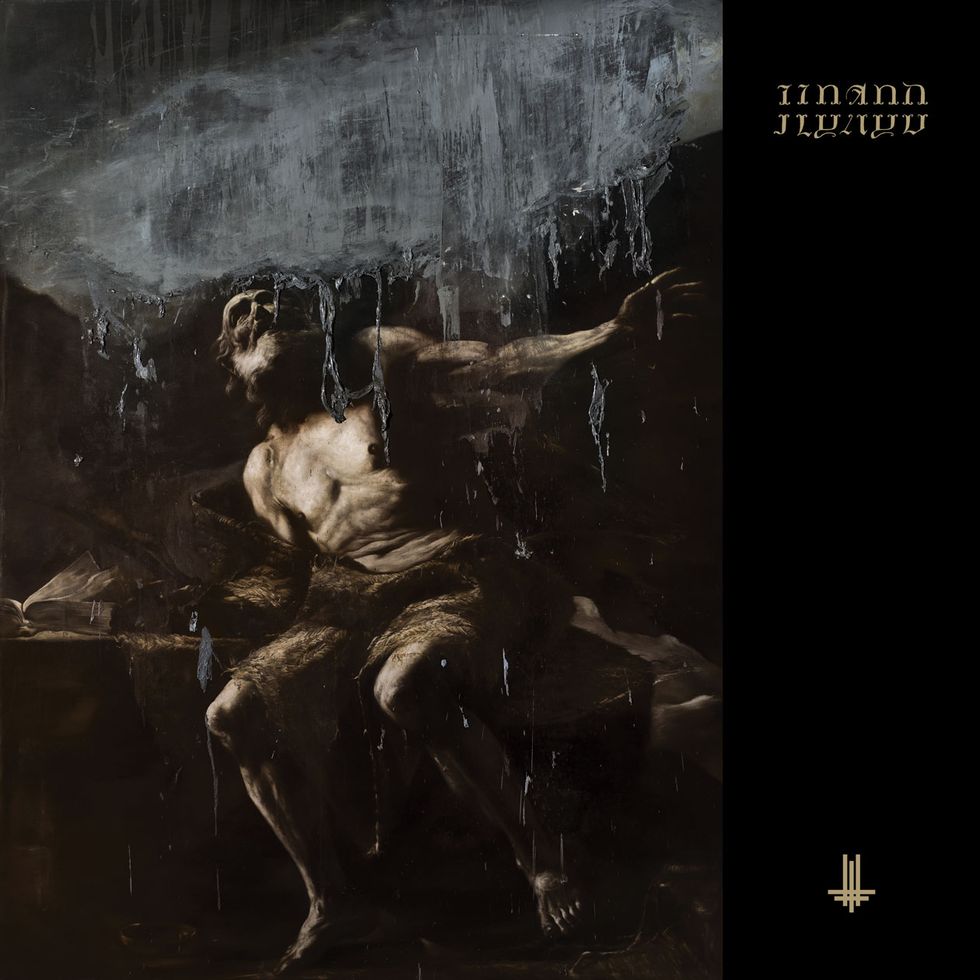
TIDBIT: Nergal’s main guitars for tracking the band’s 11th LP were his signature ESP single-cuts, but Fenders—primarily a Telecaster—Gibsons, and Jacksons also factored into creating guitar sounds with a bit more classic-rock crispness.
And yet it’s still a very cohesive album—and as heavy, in its own way, as anything the band’s put out.
A lot of bands in our world play it safe and don’t want to risk losing their fan base. They follow their pattern and do the same record over and over again to stay “credible” and avoid that. Me … I need to stay credible to myself, first and foremost. My own inspiration and being honest with myself comes first, regardless of whether other people follow it. Stagnation really equals death, and I don’t want to stay in the same place. So on one hand, I do want to remain faithful to the sound that we started with—and you can hear it on this record maybe even more than anything on The Satanist with a song like “Wolves ov Siberia”—but, on the other hand, there’s stuff that you’ve never heard before on a Behemoth record … pretty adventurous ideas that are far-removed from extreme metal. It seems to be connecting with people. We did a meet and greet yesterday here in Poland, and when I asked what people’s favorite song on the record is, a lot of people said “The Crucifixion Was Not Enough…” which is a very different song for Behemoth. It means a lot to me that people seem to get it. It’s an exceptional compliment when people single out a song like that.
Speaking of “Wolves ov Siberia,” it’s perhaps the most traditional black-metal song the band has put out in years. How do you approach writing a riff like that without plagiarizing your past work?
That song is sort of the mirror song, conceptually, to “We Are the Next 1000 Years,” which is why it’s placed so early on the album and in a spot that correlates to “We Are the Next 1000 Years.” It’s supposed to represent the beginning for us both sonically and in its placement on the album.
When it comes to writing things like the riff on “Wolves,” I’m not necessarily above repeating myself. There are certain parts that I see as Behemoth signatures at this point. For example, the main guitar theme on “God = Dog” is very similar to the guitar part on “Conquer All” [from 2004’s Demigod], with that alternating high-to-low marching chord idea. That kind of riff is one of my favorite things to do on the guitar, to the point that it’s on a lot of our albums and is very much me. To my thinking, there’s nothing wrong with having sort of trademark ideas, but it really comes down to how you finish them and how you build the things around them. For example, the main guitar theme of “God = Dog” was not very exciting to me until we came up with the song’s beginning and ending, and it was the context of having all of it together that made the song exciting. So it’s not about the riff so much as the context it’s in, and that’s a big thing for this band. Riffs only make sense if you put the right elements together, and that’s when a riff can impress in a song. I don’t know that Behemoth is really a killer riff band, but when we combine that element with other things and we put it all together and pour our “sauce” on it … that’s when things get exciting for me. I really want Behemoth to be more of an experience and a bigger entity than just a rock ’n’ roll- or metal-riff-based band.
Nergal (left) and lead guitarist Patryk “Seth” Sztyber onstage at the PlayStation Theater in New York City
on November 3, 2018. Photo by Jimmy Hubbard
Can you talk about your songwriting process?
All the stuff on The Satanist was composed in regular standard tuning on a Fender Telecaster, using thin string gauges, and that felt very unusual for me. At the time, I had decided to experiment, [because] most guitarists know how much the type of guitar—and the way it’s set up—influences what you write and how you play … which is why you don’t see any country musicians using B.C. Rich guitars. Certain tools can bring out very specific sounds and music, and I felt like that method worked really well on The Satanist. So, this time around, I wrote much of the album on a Gretsch guitar—which are really no good for shredding or speed metal. When I play that guitar, I do it in the same way people might when they sit around a campfire and play with friends—casually, using a lot of big open chords. I give the parts more negative space, too. I also find that when I write on that guitar I let song structures breathe more, and that really informed the songwriting on this record. That’s why there’s so much air in these songs.
The new album’s production sounds extremely organic—especially compared to how synthetic many black- and death-metal recordings sound these days. Was that intentional?
Yeah! Absolutely. The biggest problem I have with black or death metal these days is, when these records get to the mixing and mastering point, they make the instruments compete with each other. When I say that the new Behemoth album is a rock-oriented black-metal record, what I mean is that we make space for every instrument to shine. We build the song around each element having space to shine on its own. When they all come in together as one, in a big fucking climactic moment, that’s a huge trick to pull off. That’s what I’ve learned from listening to AC/DC, the Beatles, the Rolling Stones. Burzum never taught me that. Morbid Angel—or really anything in that [metal] world—never taught me that. So, I really like to take that philosophy from the rock world into the world of extreme metal.
Behemoth did quite a bit of touring with Slayer, and I’ve always appreciated the way the instruments on their classic albums have their own space—especially on the ones Rick Rubin produced. Those songs are heavier because they rely on musical ideas rather than loud production and a dense mix.
I totally agree with that. I was blasting South of Heaven on my car stereo a few days ago while driving around on this press tour, and I had that same exact reflection and made that parallel with I Loved You … and Slayer in particular. We really wanted to build layers and make music in a multidimensional way, and blending instruments in a mix without forcing them to compete with each other is the key.
Did you learn anything as a guitarist from your time on the road with Slayer?
Kerry King and Gary Holt are both amazing, unique guitarists. Gary Holt is such an incredible shredder. He’s one of the best guitar players in the genre and I fucking love his style. And Kerry’s right hand is really untouchable. He’s like a guitar soldier to me. Kerry looks and plays like a reckless, relentless, repentless, unstoppable machine. Those two are a part of my guitar hero firmament and are inarguably some of the most important heavy metal players out there—especially considering that they’re still out there kicking ass on the road and doing it right.
For me, it’s very important to look at a guitarist holistically: how you present yourself, how you approach the stage, how you sell what you’re doing as a musician to the crowd—and that’s something few people do as well as Gary Holt and Kerry King. I can be totally indifferent about a player if they’re not fully involved in their performances, the way Gary and Kerry are. They’re really like demon brothers, and I just love them and try to take what I can from watching them.

Guitars
ESP LTD Nergal-6 with Fishman Fluence Modern Humbuckers (Alnico in neck position, Ceramic in bridge)
ESP LTD HEX-7 Nergal Signature V with EMG 81-7 and 707 pickups
Fender Telecaster
Takamine acoustic
Amps
Peavey 5150
Bogner Uberschall
Splawn head
Effects
Ibanez Tube Screamer
Boss NS-2 Noise Suppressor
Strings and Picks
Dunlop 1 mm picks
D’Addario .011–.056 string sets
Who else would you cite as particularly influential to your guitar journey?
One of the most underrated guitar players out there, and one that had a big impact on me, is Mantas [Jeffrey Dunn] from Venom. I was maybe 8 years old when I was confronted with Venom’s art, and I was hooked right away and became a fan for life. I think Mantas is amazing! Tony Iommi, Jimmy Page, and Angus Young are really important to me when it comes to classic and more obvious guitar players. Modern guys that I like that aren’t metal players, but have a unique sound and a certain kind of charisma to their playing that I really appreciate, are Lenny Kravitz and Jack White. I just saw Jack White a few days ago in Krakow and he was fucking amazing! I always try to steal something from people—even from other genres—and when I watch Jack White, even though he’s from a different galaxy, I want to find something in his playing to sneak into Behemoth’s music.
From my own genre, Euronymous from Mayhem, Tom G. Warrior from Celtic Frost, and Trey Azagthoth of Morbid Angel are some of the most innovative guitarists in the extreme-metal world.
If you look at each of the people I’ve mentioned across genres, in most cases they’re frontmen or otherwise very charismatic and have this ability to hit the stage and impart a sense of magic to a crowd. It resonates, and it’s immensely impressive to watch people that can do more than just hold the instrument and play this or that very well. It’s having a bigger picture of musicianship and performance that I look for and find inspiring.
Tell me about the Gretsch you used to write the new album?
I wound up getting a Gretsch endorsement through my other band, Me and That Man, and they were really generous. I have a White Falcon, a Billy Duffy signature Black Falcon, and a Duo Jet reissue that’s amazing. I really love those guitars and I use them a lot, but I just write on them when it comes to Behemoth.
Strats, Explorers, Les Pauls, AC30s, and a healthy amount of delay help form some of the most iconic tones ever recorded. Famed tech Dallas Schoo walks us through the ins and outs of The Edge’s expansive setup.
This past June, PG traveled to the Wells Fargo Center in Philadelphia to catch U2’s eXPERIENCE & iNNOCENCE Tour. Before the band’s soundcheck, John Bohlinger hung with Dallas Schoo, who has been taking care of The Edge’s ever-changing collection for over 30 years.
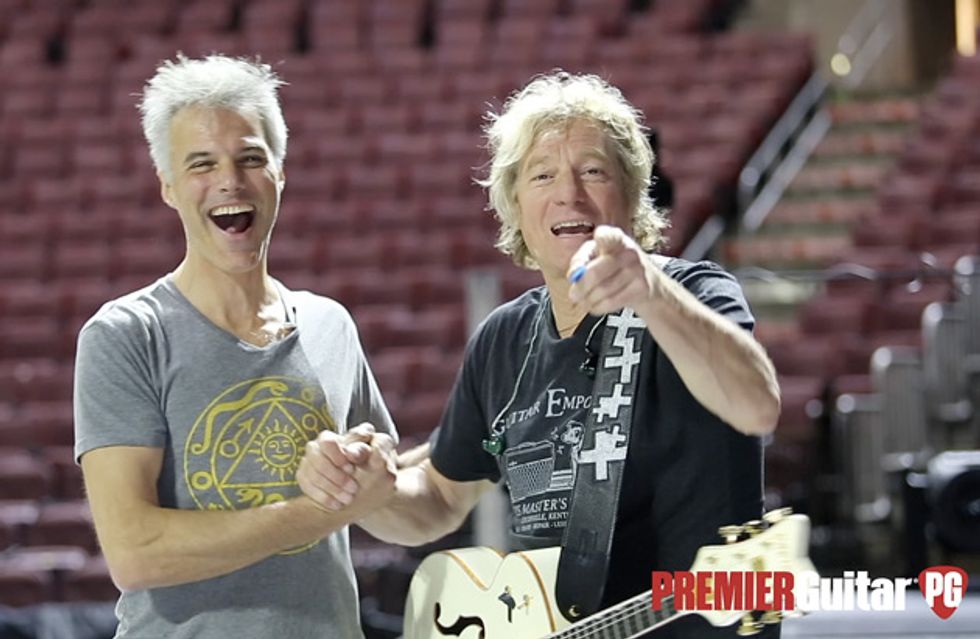
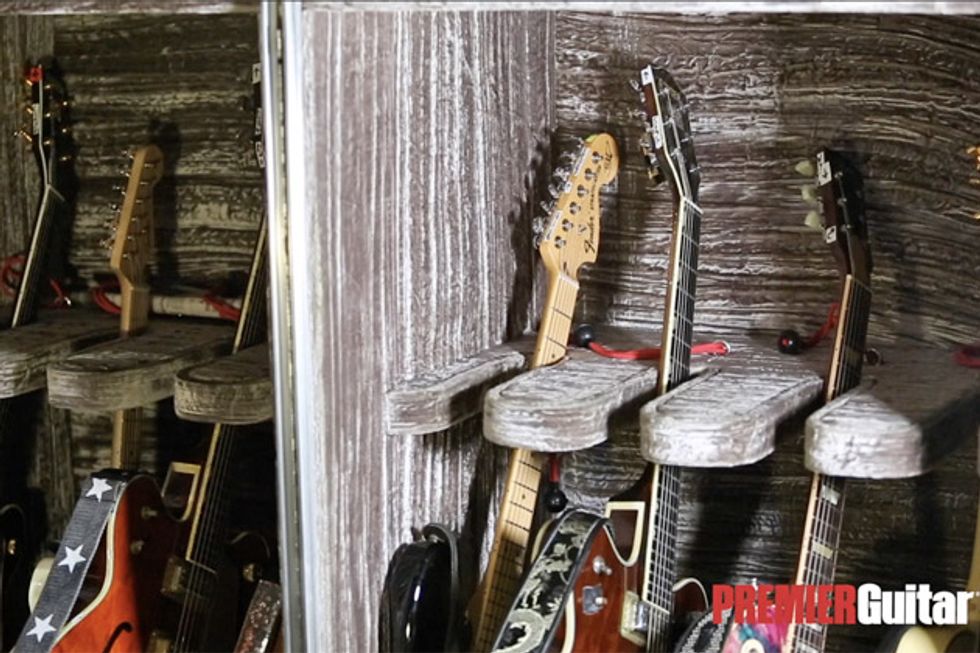
The Edge tours with 45 guitars. He performs with 18 to 20 different guitars every show and has a backup for every one of them. The Edge does not endorse any string company but has Dallas Schoo constantly experimenting with different brands and gauges for each guitar and tuning.
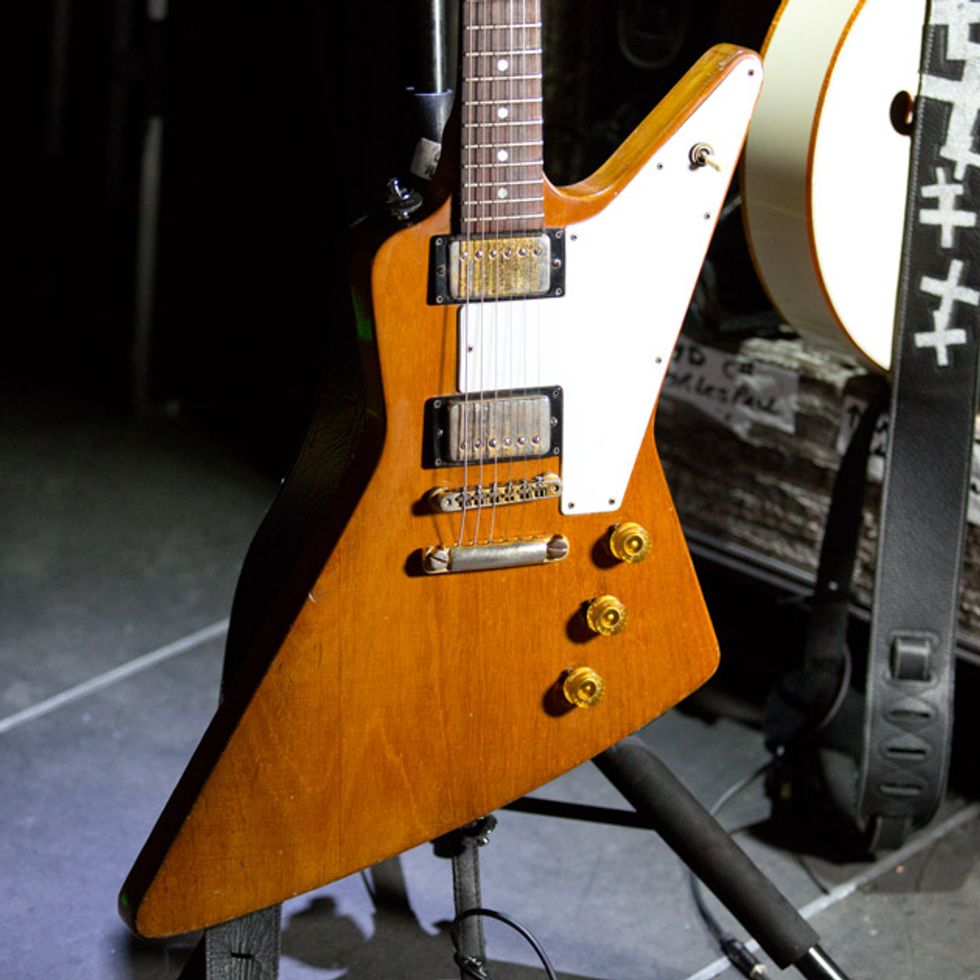
In 1978, on a trip to the United States with his family, a seventeen-year-old Edge bought this 1976 Gibson Explorer. This guitar was there for the birth of U2 and has been part of nearly every tour and session since. Edge now owns eleven ’76 Explorers and currently tours with three of them. They are all stock and nearly identical. And to be clear, Dallas Schoo is always on the look for more.
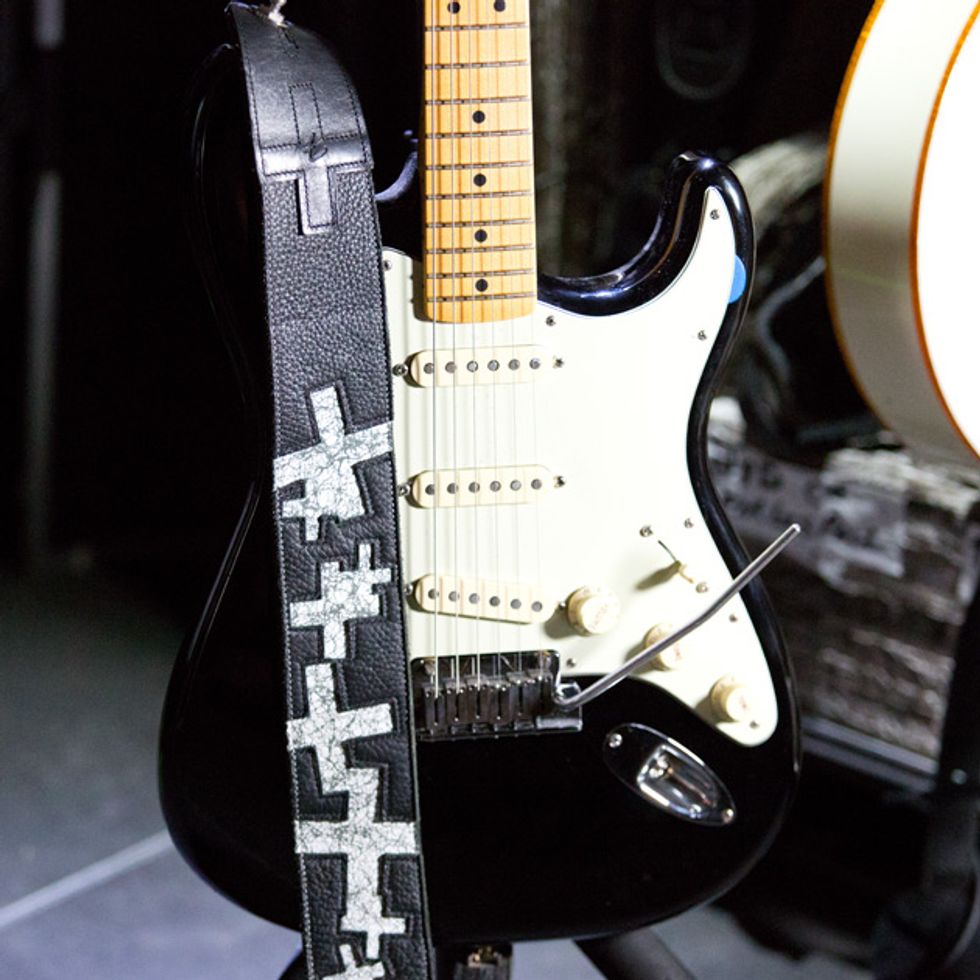
Fender approached The Edge about a signature model based on some of his old favorite Strats. This namesake model features a large headstock, a Dimarzio FS-1 bridge pickup, and two custom staggered Fat ’50s Fender single-coil pickups. The strap on was designed by The Edge.
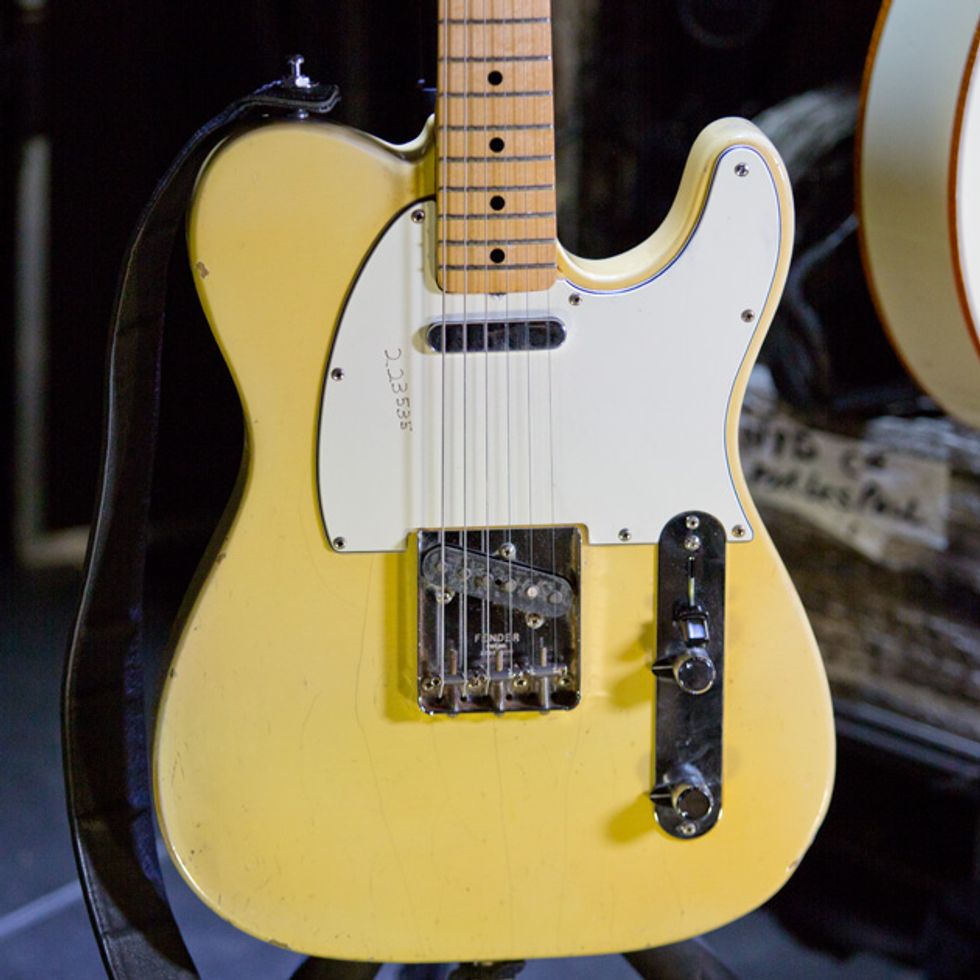
The Edge’s 1971 Fender Telecaster is totally stock with the exception of the mysterious numbers etched into the pickguard.
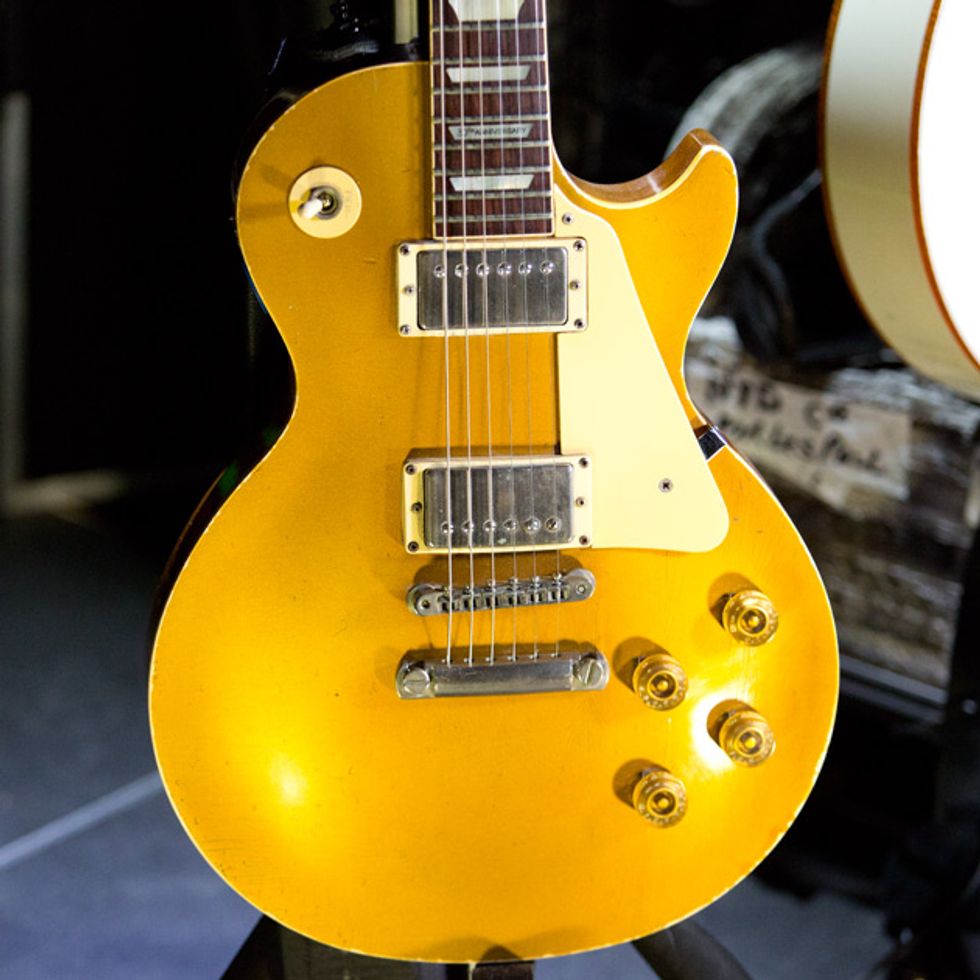
Although he mostly plays vintage guitars, this 1988 Gibson Gold Top ’57 reissue remains one of the Edge’s favorites.
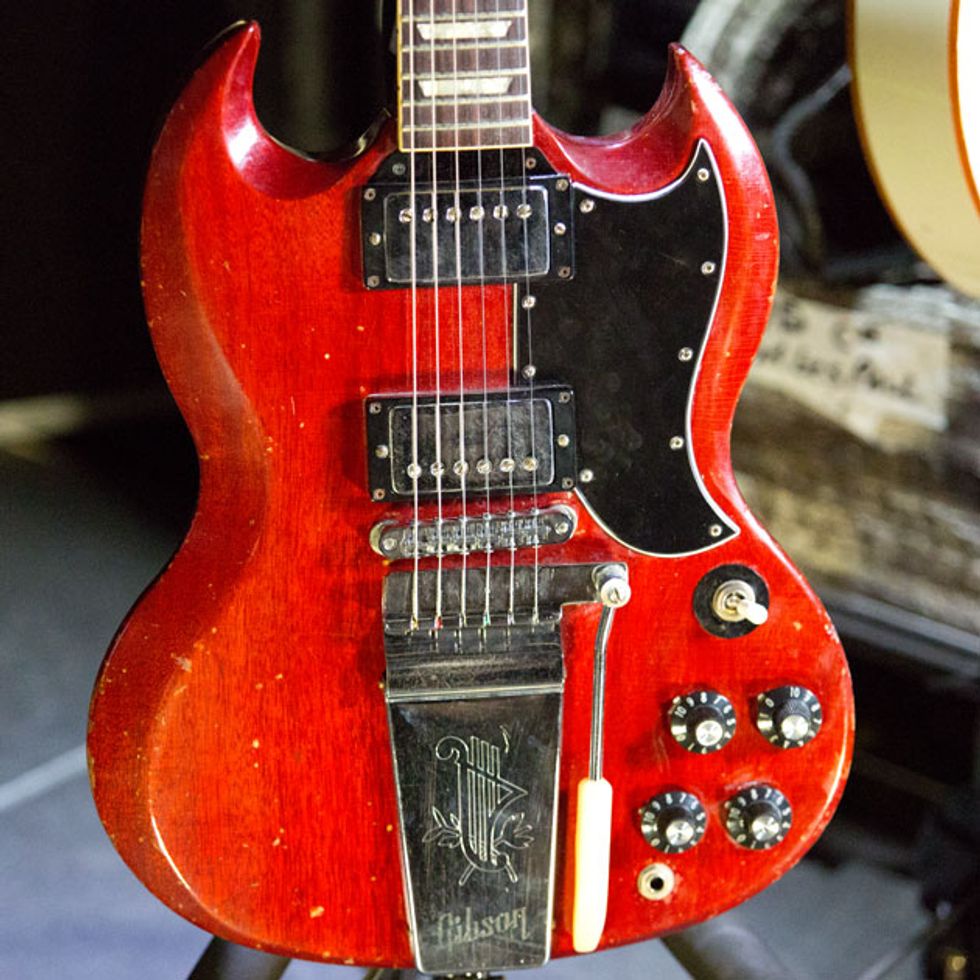
Edge’s 1966 Gibson SG is all stock and even includes the patent-sticker pickups.
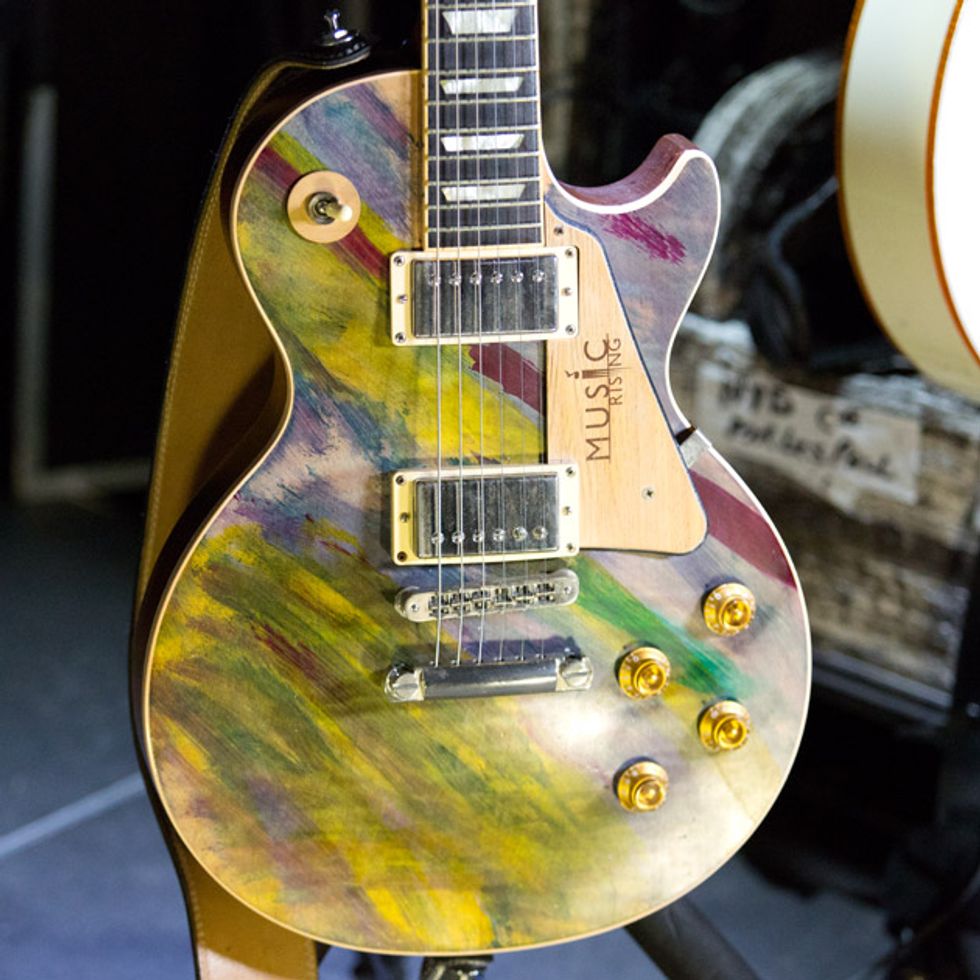
Edge carries two Gibson Music Rising Les Pauls. These guitars were part of a fundraiser to help New Orleans musicians get new instruments to replace those that were lost in Hurricane Katrina. Each guitar features Mardi Gras-influenced artwork to celebrate NOLA’s rich musical heritage.
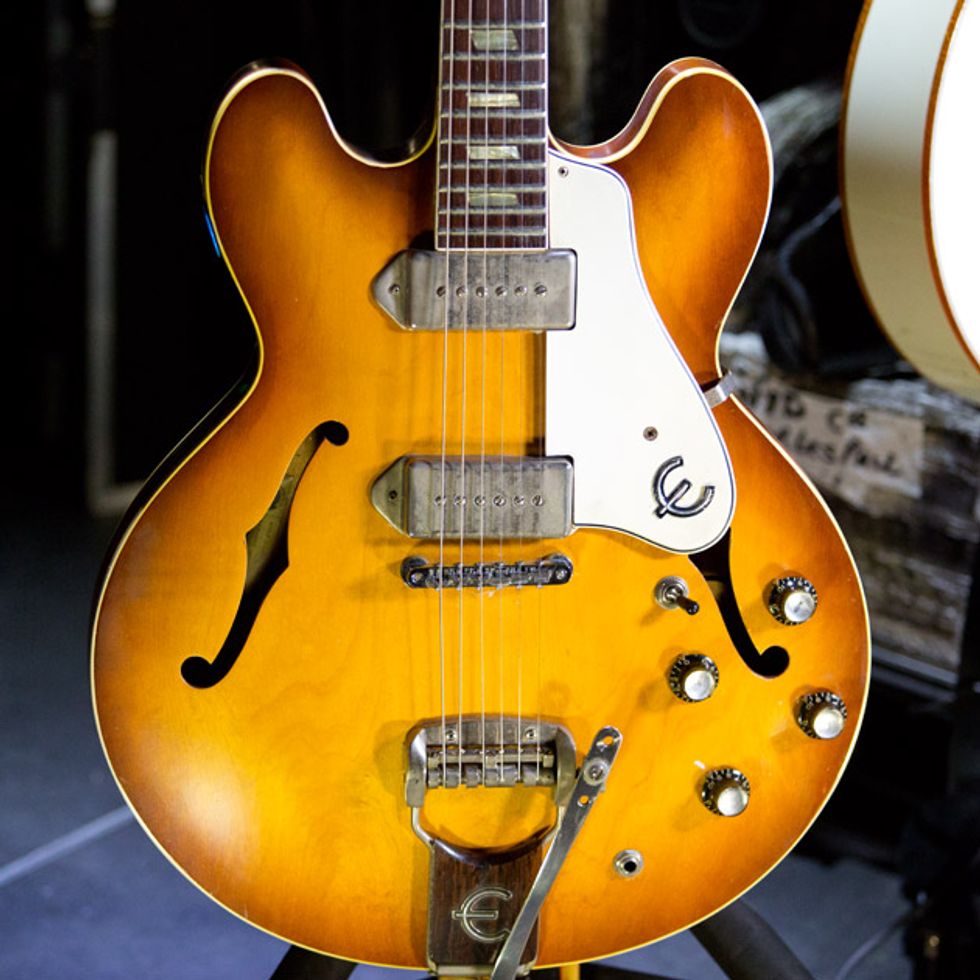
Here is Edge’s 1964 Epiphone Casino that is completely stock.
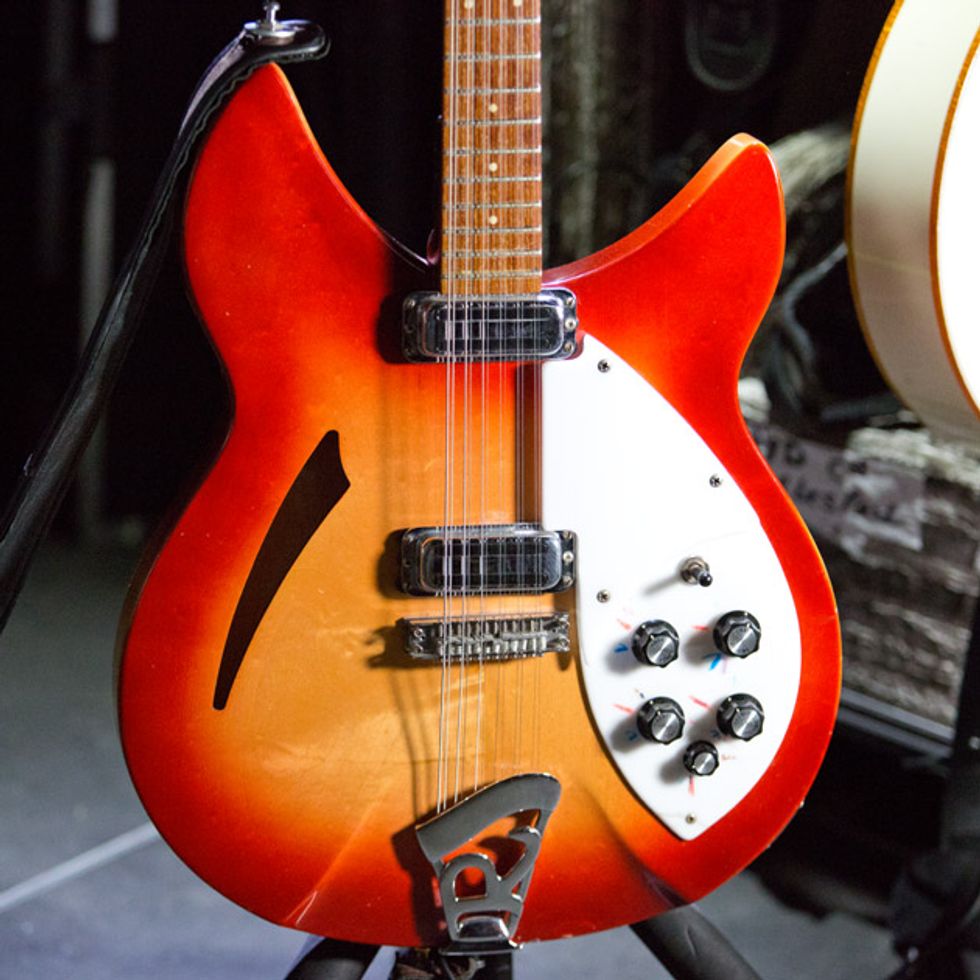
Like most of Edge’s vintage guitars on this tour, this 1967 Rickenbacker 330/12 is all stock.
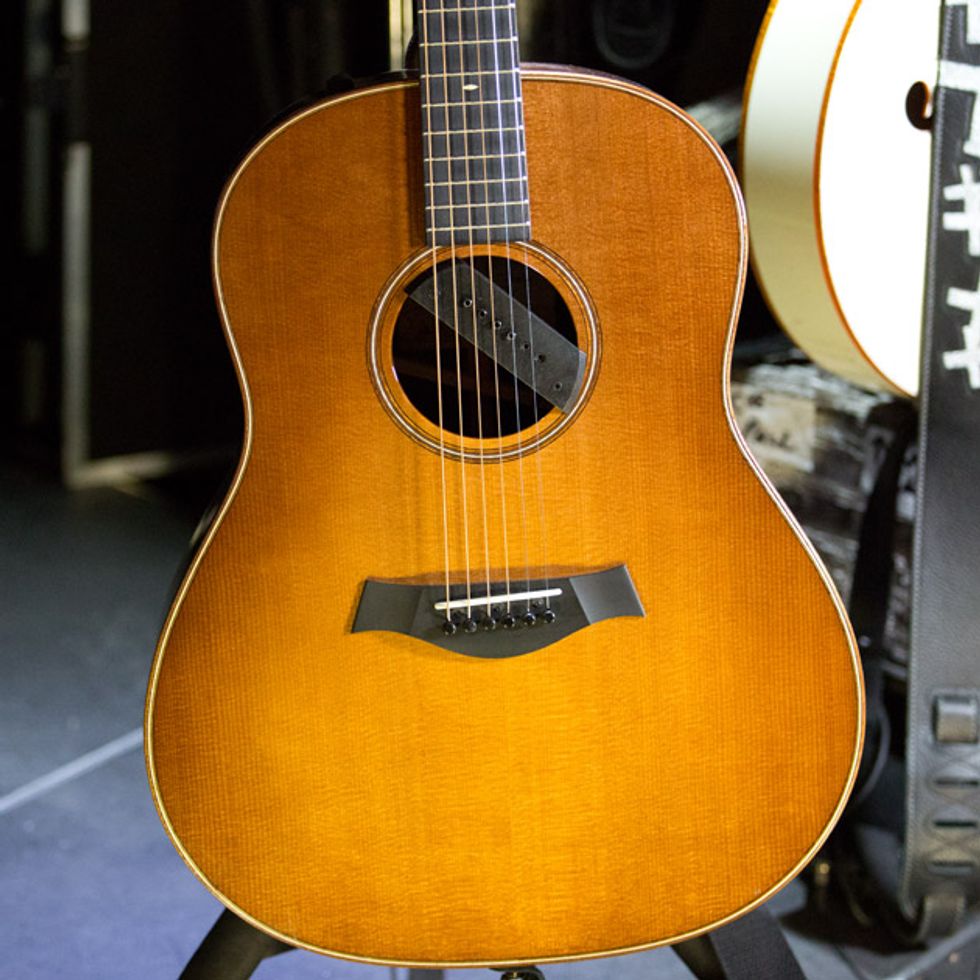
Edge’s new Taylor prototype features a second Sunrise S-1 LW/J sound-hole pickup placed at an angle and is used with the standard Taylor electronics.
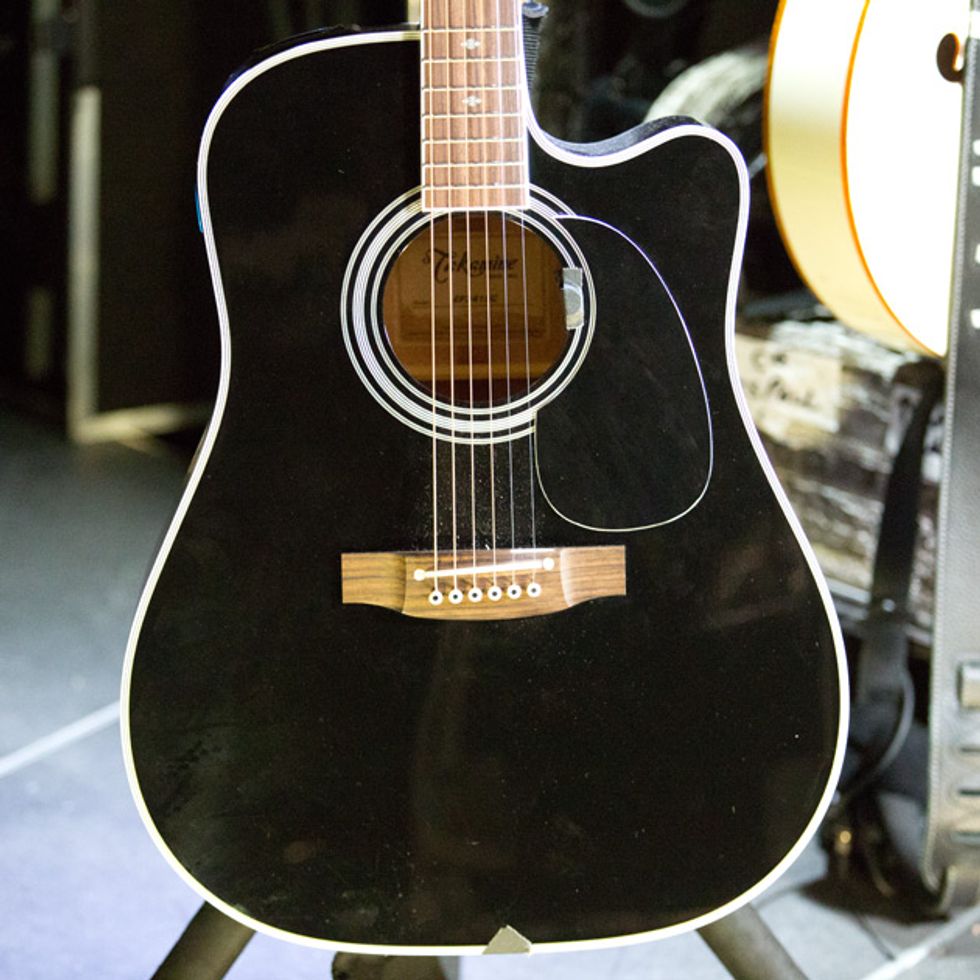
This Takamine EF341SC was a gift to Edge from Bruce Springsteen.
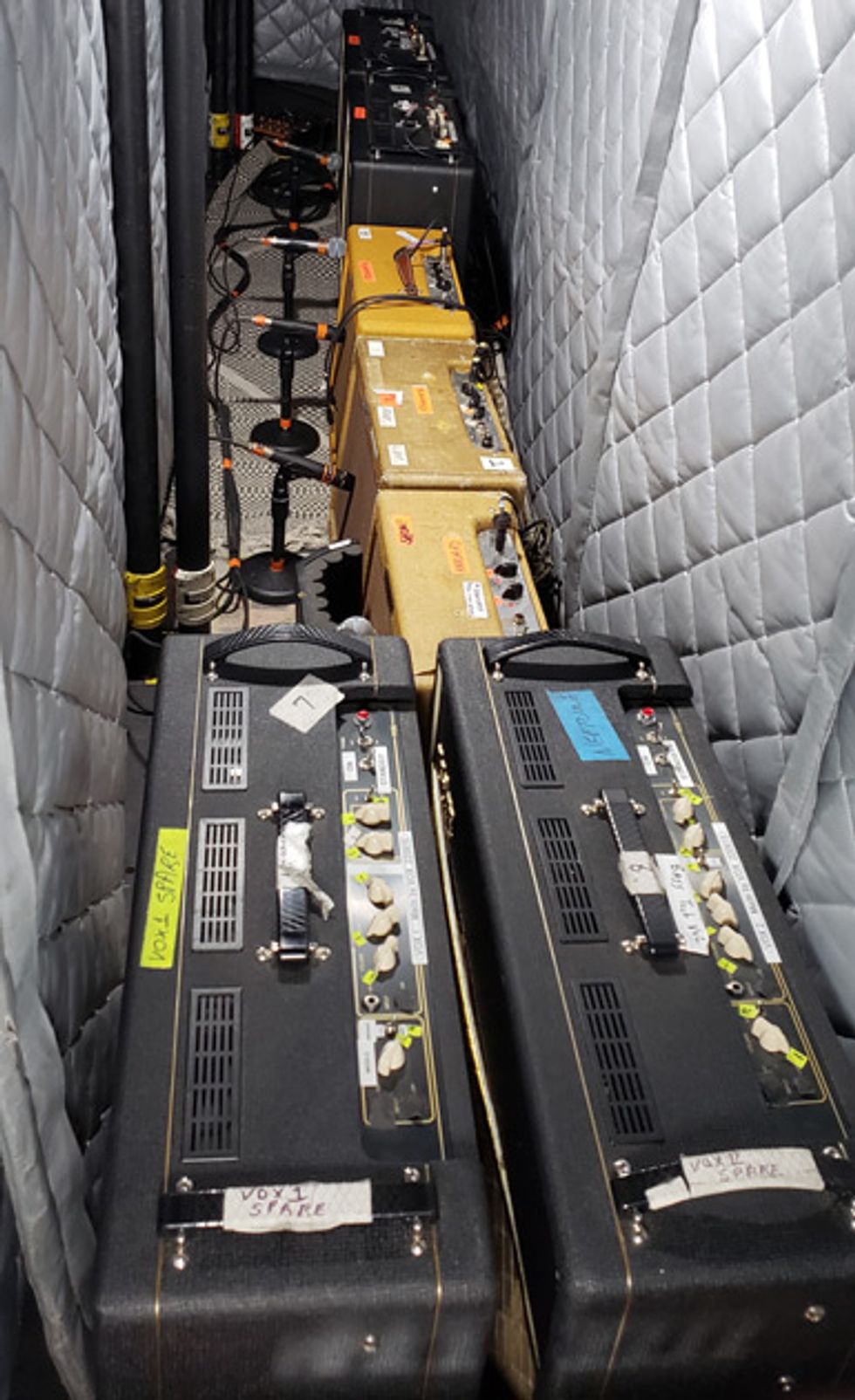
The Edge’s tone comes from combining various vintage and new amps. Under the stage sits Amp Alley, which houses a baffled row of glowing tubes and cranked speakers. Of course, each amp has a spare standing by.
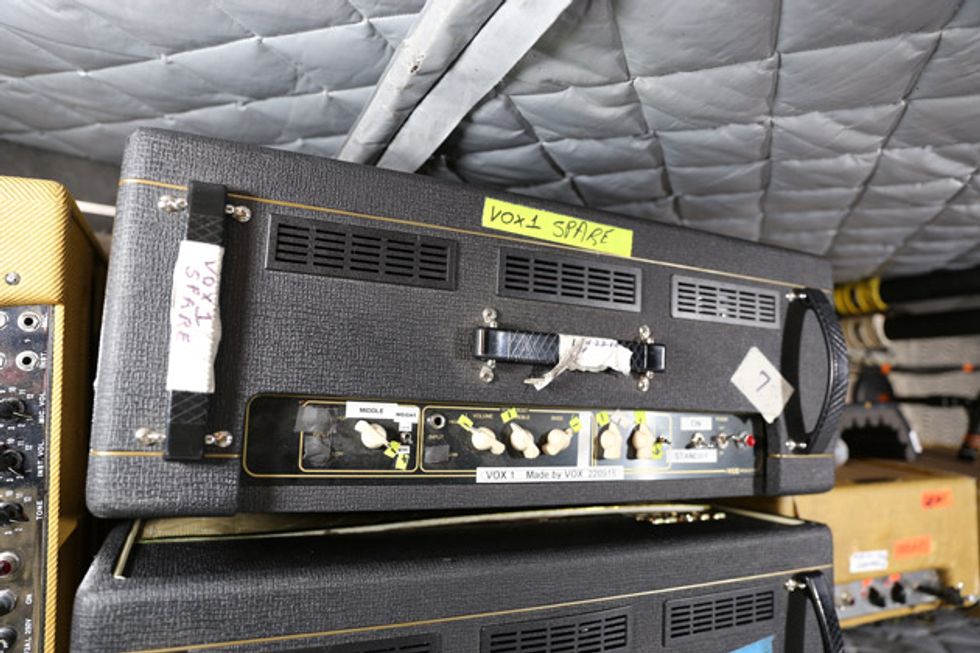
Vintage Vox AC30s have been a cornerstone of Edge’s tone since his earliest days. On this tour he takes out two 2015 Vox AC30TB combos handwired by Dave Clarke and two 2016 Vox AC30s that Clarke tweaked.
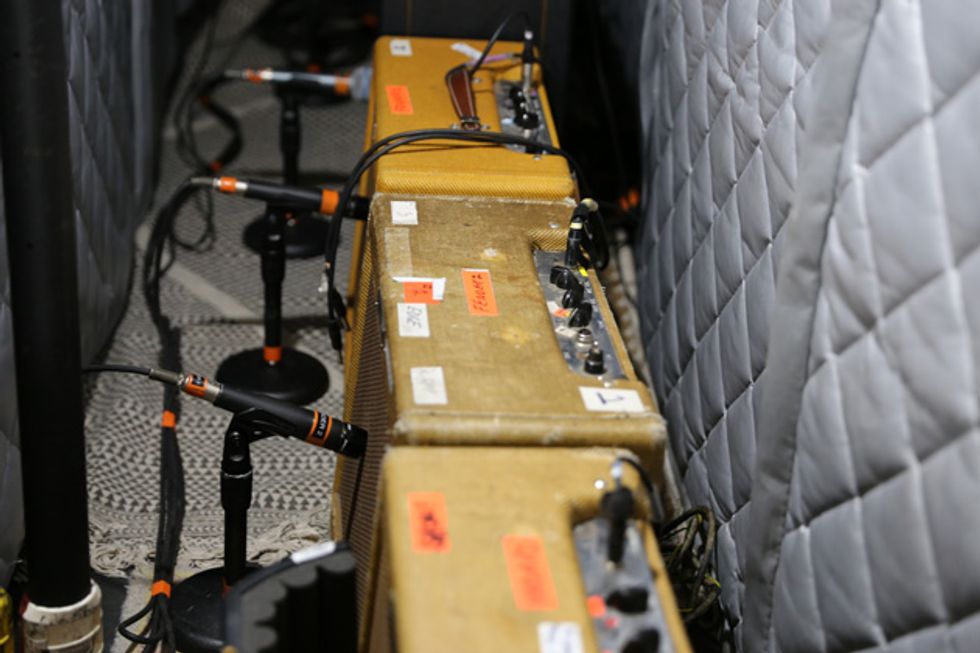
Three tweed-style amps round out Edge’s stash. From the top we have a Fender Edge Deluxe, a 1957 Fender Tweed Deluxe, and finally a 1957 Fender Harvard.
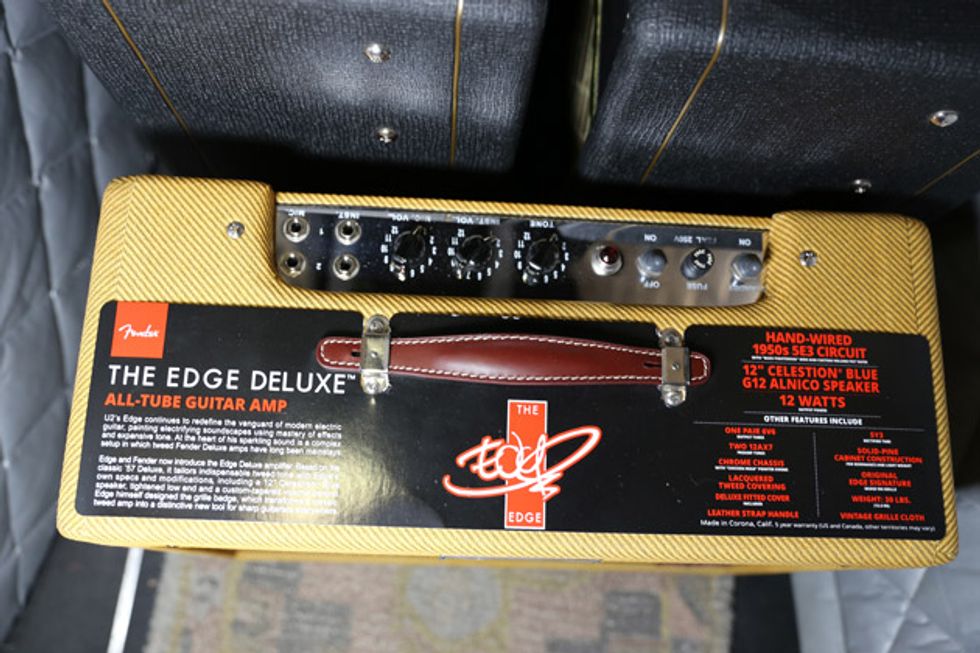
The only amp onstage is a lone 2017 Fender The Edge Signature Deluxe Combo.
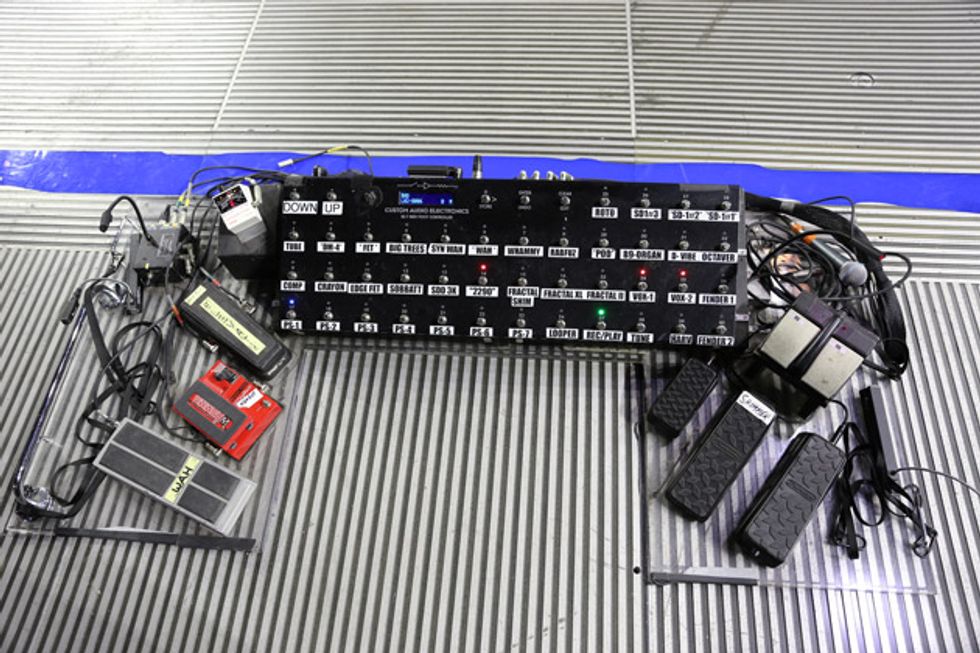
The Edge has worked with Bob Bradshaw for years to help create his live rigs. The effects are controlled by two Bradshaw RS40 controllers: one is onstage, and a second unit sits with Dallas. In addition to the RS40, Edge has a DigiTech WH-1 Whammy, a Boss 500V Expression Pedal for his Custom Audio remote wah, two Dunlop Volume X pedals (one for reverb, one for delay), and a Dunlop Mini Volume X, which is used for quick octave pitch shifting.
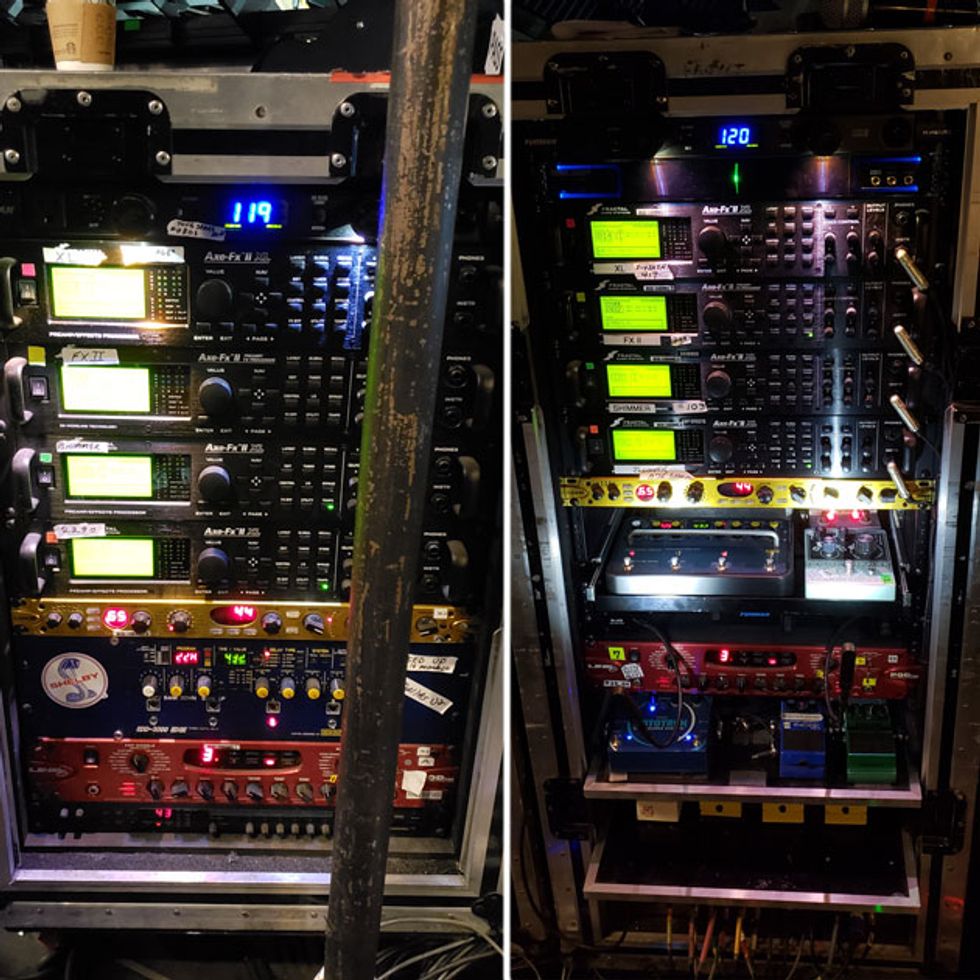
Edge’s racks hold Furman PL-PRO DM C E power conditioners, three Fractal Audio Axe-Fx II XL units, a Korg Pitchblack Rack Tuner, a custom Line 6 DM-4, a Line 6 Pod Pro, a Korg SDD-3000, an Ibanez TS-9 Tube Screamer, a Boss FA-1 FET boost, a Boss CS-2 Compression Sustainer, a Boss OC-3 Super Octave, a prototype Fender distortion pedal, a Diamond VIB1 Vibrato, an Electro-Harmonix B9, a DigiTech SynthWah, a Voodoo Lab Pedal Power Mondo, four MIDI Solutions Mergers, a Line 6 M5, three Boss SD-1 Super Overdrives, a JHS Crayon, a sobbat DB-2 Drive Breaker, and several Bradshaw-designed Custom Audio Electronics splitters, loop boxes, and interfaces.
Click to subscribe to our weekly Rig Rundown podcast:


